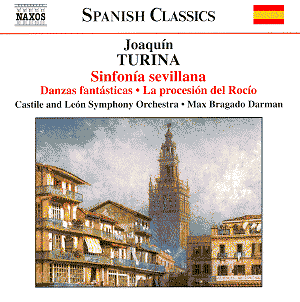Turina’s pastoralism, pictorialism, colouristic impressionism
– call it what you will – boils down to several things and one of them
is this; he was a wonderful orchestrator. Time and again listening to
this really delightful disc I smiled at the sheer rightness of the string
and wind writing, the way the textures are never clotted, the skill
with which every strand is given a glinting life, the weave and fleck
of light, the extrapolation of the most lucid of textures.
The Sinfonía Sevillana was published
in 1920 and this three-movement evocation of Andalusia is bathed in
impressionist languor and drama. Panorama, the first movement,
opens in a succulent impressionistic haze – so rich and deep you can
smell it – with increasing shafts of rhythmic motion ushering in glorious
layers of string and warm brass. Lest one mistakes this for generalized
pictorialism there are so many nooks and crannies in Turina’s utterly
deceptive orchestration that the music keeps quiveringly alive: the
art – Parisian style, via the Schola Cantorum – that conceals art. The
second panel, Por el río Guadalquivir (By the river Guadalquivir)
starts with a violin solo, expressive and very well played here, and
some wind/brass exchanges. The orchestration here is again sumptuous
– aerated and not lazily impressionistic and opening into affectionate
directness as it develops. The Fiesta finale is evocative and lyrical,
packed with melodic contrast and Iberian colour – sultry, cool
or both and closing with a joyful brass peroration.
Danzas fantásticas again dates from the
immediate post First War period as Turina gained instrumental and orchestral
mastery over his material and found a means through which to channel
it. Based on the Jota (think de Falla) there is more gorgeous vibrancy
and affectionate swing in the opening of the three movements and some
piquant wind writing in the second – Ensueño – with its
insouciant rhythm and flowing ease. The finale – a farruca dance – suggests
flamenco and torrid nights, revelling once more in the orchestral choirs
and sectional writing – the furtive winds suggestively strong over running
lower string pizzicati; great colour once more and oozing life.
Ritmos – a ballet – was intended for ballerina
Antonia Mercé but in the end had to do with life in the concert
hall and was first performed by the Orquesta Pau Casals, conducted by
the composer himself. The various dance forms embedded in the score
make for vibrant – and sometimes sorrowing – fluidity (the Danza lejana
is especially well orchestrated in this respect) and the rhythms generate
their own teeming and choreographed life. Finally La processión
del Rocío, Turina’s first (1912) orchestral work – a symphonic
poem of warmth and affectionate pictorialism that takes in village life
and impressionistic verdancy in abundance.
Darman directs his forces with real acumen and care;
sectional balance is maintained but there’s a burnish to the playing
that is both attractive and evocative. Turina has seldom seemed so palpable
and so alive.
Jonathan Woolf

